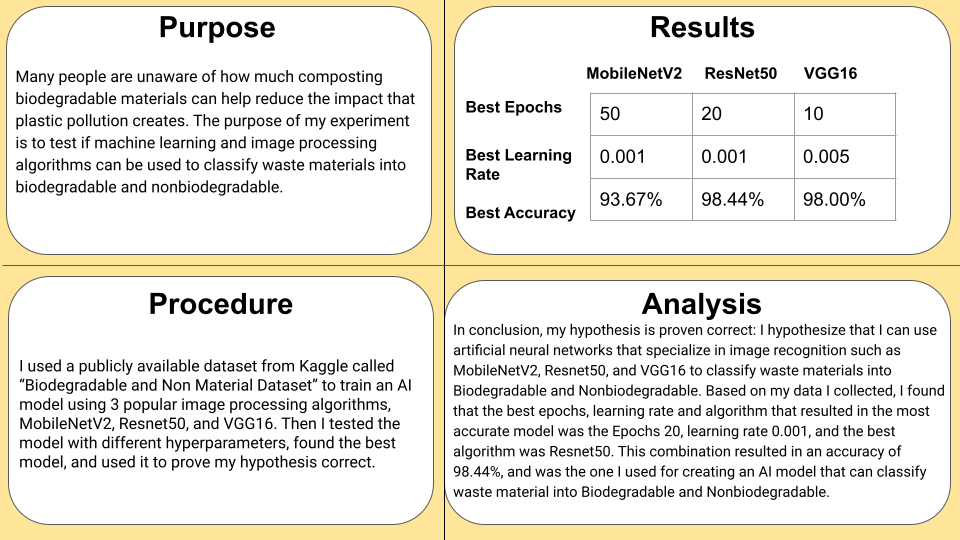Classification of waste materials into biodegradable and nonbiodegradable using machine learning
Abstract:
Bibliography/Citations:
ArXiv:1801.04381v4 [CS.CV] 21 Mar 2019, arxiv.org/pdf/1801.04381.pdf. Accessed 31 Jan. 2024.
Boesch, Gaudenz. “Image Recognition: The Basics and Use Cases (2024 Guide).” Viso.Ai, 1 Feb. 2024, viso.ai/computer-vision/image-recognition
EPA, Environmental Protection Agency, www.epa.gov/sustainable-management-food/composting. Accessed 12 Feb. 2024.
Kaza, Silpa, et al. What a waste 2.0: a global snapshot of solid waste management to 2050. World Bank Publications, 2018.
- “Non and Biodegradable Material Dataset.” Kaggle, https://www.kaggle.com/datasets/rayhanzamzamy/non-and-biodegradable-waste-dataset. Accessed 13 January 2024.
Additional Project Information
- Kaggle - Non and Biodegradable Material Dataset
Research Plan:
Procedure:
- Download Non and Biodegradable Material Dataset from Kaggle repository.
- Split the dataset into 3 categories: 80% train data, 10% test data, and 10% validation data.
- Using the image classification algorithm MobileNetV2, tune the hyperparameters, Epochs and learning rate, by training the model with the training data, and then testing it with the new images (validation data). Record the accuracy of the model when tested. Repeat this with different hyperparameter combinations.
- Generate a multi line plot graph with the data you recorded using python code to ensure the best combination of hyperparameters.
- Find the best model using the data collected and save it in a file.
- Generate a confusion matrix showing how many images the AI predicted right and wrong.
- Repeat steps 3-6 with the algorithms VGG16 and Resnet50.
- Determine the best AI model for the data based on all the experiments from steps 3-7.
- Complete data analysis and conclusion.
Questions and Answers
1. What was the major objective of your project and what was your plan to achieve it?
The major objective of my project was to train an AI model that can classify images of waste material into biodegradable and nonbiodegradable. I planned to achieve this goal using three popular image processing AI algorithms to determine the best accuracy to prove my hypothesis correct.
a. Was that goal the result of any specific situation, experience, or problem you encountered?
Many people can’t tell if something is biodegradable or not, and many materials go to waste, so that's why I wanted to create an AI model to help solve the problem.
b. Were you trying to solve a problem, answer a question, or test a hypothesis?
I was trying to test a hypothesis that the use of deep neural networks to classify images of waste materials into biodegradable and non-biodegradable materials is possible with an accuracy greater than 95%.
2. What were the major tasks you had to perform in order to complete your project?
The major task in my project was to find the model with the best accuracy. I had to find the best combination of Epochs and learning rate, along with the best algorithm.
a. For teams, describe what each member worked on.
N/A
3. What is new or novel about your project?
a. Is there some aspect of your project's objective, or how you achieved it that you haven't done before?
This was one of my first projects on Artificial Intelligence. This project helped me expand my knowledge of Convolutional Neural Networks, specifically image processing algorithms.
b. Is your project's objective, or the way you implemented it, different from anything you have seen?
My project is unique because I used 3 different image processing algorithms to train the models using the dataset. This helped to get better results for the best model of the dataset.
c. If you believe your work to be unique in some way, what research have you done to confirm that it is?
Based on my research I found a few other projects that were implemented on the same topic in different ways. Since the algorithms are common, similar procedures were followed but the results were different.
4. What was the most challenging part of completing your project?
One challenging part of my project was learning about image processing and going in depth while learning about Artificial Intelligence.
a. What problems did you encounter, and how did you overcome them?
One problem I encountered during my experiments was during training AI models. Everytime I ran the model with different hyperparameters it would take a long time. I solved this problem by taking advantage of the coding platform I was using. I got Google Colab Pro, which was a paid upgrade that provided me with more GPU and sped up the experiments.
b. What did you learn from overcoming these problems?
Sometimes during my experiments, the code had errors and flaws. I had to try different things to make sure that it was successful. I learned from these problems that coding requires many changes and modifying until it is correct.
5. If you were going to do this project again, are there any things you would do differently the next time?
If I were to do this again, I would want to try this again with more categories that are specific. For example, instead of having 2 categories, non biodegradable and biodegradable. I could specify what type of material the categories were such as plastic, metal, rubber, wood, etc.
6. Did working on this project give you any ideas for other projects?
I enjoyed learning about Artificial Intelligence and would like to continue to explore more about it in the future. I am also very interested in Robotics. In my next project I would like to combine AI and Robotics to solve a problem.
7. How did COVID-19 affect the completion of your project?
Because my project was conducted indoors and at home, COVID-19 did not affect my experiment.

